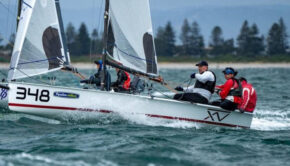GROWTH: Reflections from the President
Published on April 8th, 2013
Tom Hubbell, President of US Sailing, provides successful examples of how one design classes can remain healthy…
Introducing newcomers to their boats…
Picture me about five years ago getting acquainted with a J/22. Step one, how do you get up there to rig the thing as it sits on the hard? (Need a ladder.) Step two, how do you safely get the thing into the water? (One big strap up to the hoist.) And so on… Step 10, how does the helmsman get across the boat and around the mainsheet-traveler complex without making a scene or hitting another boat? (Very carefully!)
Here are my keys to onboarding the new kids:
* Get a mentor and get the videos to learn the basics. The Eibers were my mentors and I bought the J/22 video. I needed more help on steering a narrow lane upwind but that’s another story. The proven strategy for introducing and keeping newcomers is very supportive, tireless, insightful mentoring.
* Limit failure. Adult learners don’t like failure any better than kids do so we need to anticipate pitfalls and coach them. And we need to be quick to pick them up when they do fall. We also want to avoid throwing them into the pool over their heads until they’re ready. Going out in a big breeze in an unfamiliar boat probably is not wise. As I learned, sailing a major regatta in a still-unfamiliar boat is the formula for big disappointment, a good slice of humble pie.
* Connect socially. Sailors are the only people who have any idea what we’re talking about when we talk sailing, duh! We need and naturally seek like-minded people to talk to. The new kids need to be pulled into the group and made to feel welcome. And please, use name tags!
The importance of mentorship programs…
It’s no secret that small boat sailing grew because of a few dozen charming people who not only promoted the sport but continued to support and encourage their recruits. It is a simple as service after the sale. My take is that people will enjoy and stay engaged in sailing as long as they are learning – and as long as their sailing social network is active.
The Thistle Class made seminars and coaching part of the routine many years ago. The format was a day or half-day of talk and some drills on the water just before a regatta. This is still happening at many Thistle regattas. – Read on








 We’ll keep your information safe.
We’ll keep your information safe.